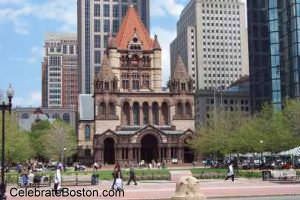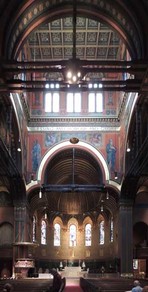Trinity Church
Introduction
Text-to-speech Audio
Images
Trinity Church, Courtesy of Celebrate Boston

Interior of Trinity Church, Courtesy of "Buffalo Architecture and History," http://buffaloah.com/a/virtual/us/boston/trinity/tc.html

Backstory and Context
Text-to-speech Audio
The current site of the Trinity Church is the third building constructed for its congregation. The church was originally founded in 1728. It took six years to secure funding to build the first church structure, and the initial cornerstone was finally laid in 1734. The first church was located at the corner of Summer Street and Bishop Alley (now Hawley Street).
The second site, located in Downtown Crossing, was destroyed in the Great Fire of 1872, which further led to the need for a new building. The congregation had already started making plans for the third church. The far grander Trinity Church on Clarendon Street, built in the very fashionable Back Bay neighborhood, was completed in 1877.
The current structure was designed by architect Henry Hobson Richardson (commonly referred to as “H.H. Richardson”). The design was inspired by the 11th century French Romanesque churches, but with Richardson’s style; hence, the term “Richardsonian Romanesque” is often used to describe the structure’s architecture. The design for the church was not his first masterpiece. However, it was the one that won him a national reputation, many imitators, and so many New England commissions that it became desirable for him to move his family from New York City to the Boston area in 1874.
Richardson’s design for the church consisted of an unusual Greek cross plan, with chancel, nave, and transepts of equal size surrounding a central square. The roof of the center square rises 211 feet into the air, forming the eminent tower. The interior of the church has a Black walnut finish. The vestibule is beautifully completed with ash and oak.
The building is not only significant for its architecture, but also for the great amount of artwork within the walls. Murals line almost every square inch of wall space in the interior of the church. Beautiful stain glass windows adorn the structure. The murals and windows of the Church were conceived by artist John LaFarge. LaFarge was a watercolor painter and stained-glass artist who trained in Paris under Thomas Couture. He was commissioned in 1876 to design the interior of Trinity Church. LaFarge’s work was much admired and he was later commission for several more important projects, including: St. Thomas’s Church, New York (1878) and the Church of the Ascension, New York (1888). A photo gallery of the church’s historic architecture and windows can be viewed on the church’s website (http://www.trinitychurchboston.org/art-and-architecture).
The Church is open to the public for prayers and tours on Sunday afternoons from 12:15 – 4:30 p.m. and Wednesdays through Saturdays from 10 a.m. – 4:30 p.m. According to the City of Boston’s Assessing Department, the church and the acre of land it is situated on are currently worth over $126 million.
Sources
Trinity Church, 1877. Celebrate Boston. Accessed April 16, 2017. http://www.celebrateboston.com/architecture/trinity-church.htm.
Assessing On-Line. City of Boston. Accessed April 16, 2017. https://www.cityofboston.gov/assessing/search/?pid=0401091000.
Trinity Church. DK Eyewitness Travel. Accessed April 16, 2017. https://www.traveldk.com/destinations/north-america/usa/boston/sights/trinity-church/.
Massachusetts - Suffolk County. National Register of Historic Places. Accessed April 17, 2017. http://www.nationalregisterofhistoricplaces.com/ma/suffolk/state6.html.
10 Buildings That Changed America. WTTW. Accessed April 16, 2017. http://interactive.wttw.com/tenbuildings/trinity-church.
H.H. Richardson: American Architect. Britannica. Accessed April 18, 2017. https://www.britannica.com/biography/H-H-Richardson.
John La Farge (1835–1910). American Art @ The Phillips Collection. Accessed April 18, 2017. http://www.phillipscollection.org/research/american_art/bios/lafarge-bio.htm.
